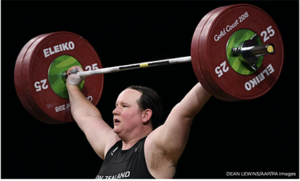Laurel Hubbard, the New Zealand weightlifter (pictured above), has been picked as the first ever transgender athlete to compete at an Olympics. It has been seen as a highly controversial decision. Hubbard is due to compete in the +87kg women’s weightlifting event next week in Tokyo. If she wins gold, there will no doubt be further outcry and claims from some cis-women weightlifters to the tune of: “ She is stealing our medals. ”
Zealand weightlifter (pictured above), has been picked as the first ever transgender athlete to compete at an Olympics. It has been seen as a highly controversial decision. Hubbard is due to compete in the +87kg women’s weightlifting event next week in Tokyo. If she wins gold, there will no doubt be further outcry and claims from some cis-women weightlifters to the tune of: “ She is stealing our medals. ”
The trans debate in sport is regarded as relatively recent and yet, back in 1977, a player called René e Richards appeared on the pro tennis scene. A spectator thought she recognised that swinging leftie serve coming off the powerful 6 ’ 2” frame and Renée was outed in the press. For she had actually been born Richard Raskin. Raskin had transitioned from male to female and was now playing on the women ’ s tour.
The USTA campaigned to keep her out of the US Open by introducing chromosome testing, but Richards challenged the decision in court. She was also a renowned eye surgeon and could afford the legal battle. Amid huge controversy, the judge declared the situation to be so unusual and unlikely to become mainstream, that he ruled in her favour.
Richards lost in the first round of that US Open to Virginia Wade although she made it to the doubles final. She retired a few years later at the age of 47. One might wonder how she would have fared had she been in her twenties, although she claimed that she wouldn ’ t have competed on the women ’ s tour had that been the case.
Richards later came back onto the tennis scene in a coaching capacity, helping Martina Navratilova for a few years.
In 2019 . Navratilova, the much-lauded lesbian role model, made the following statement: “ A man can decide to be female, take hormones if required by whatever sporting organisation is concerned, win everything in sight and perhaps earn a small fortune, and then reverse his decision and go back to making babies if he so desires. ” This was in reference to the fact that the tennis authorities don ’ t require gender reassignment surgery for transwomen players.
Athlete Ally, an organisation which promotes LGBT+ rights, promptly sacked her as ambassador, accusing her of being transphobic.
This was followed up in a documentary on the BBC, featuring a contrite Navratilova, in her search to understand the question of trans athletes a little better. By the end of it, she appeared to be somewhat bemused but was still of the opinion that a male-to-female athlete had a significant advantage over cis-women.
The Women ’ s Sports Foundation claimed that this was simply not the case, in particular with regard to those who had taken hormones prior to puberty. The average female testosterone levels are below 2 nmol/l (nanomoles per litre) and the average male ones, between 10 and 35.
I spoke to Mary Burke, the senior clinical nurse at the London Transgender Clinic about differences in sporting prowess in terms of those T levels and she told me: “ I have several male-to-female (m/f) patients who compete in local sports events. One of them has had a T-level of 0.6 for the past 2 years and yet she has a huge advantage over natal females.
“ Because she was born male, she has a far higher skeletal muscle mass which gives her more strength, which, in my experience, is even the case where transwomen have had gender reassignment surgery.
“ If you give a f/m hormone therapy, they can put on between 2.5 and 4 kg of muscle. If you give a natal male oestrogen, and even T-blockers, they never lose as much muscle. ”
“ Also, there would be a big differential between someone with T-levels of 2 versus 5 and an even more significant one between 5 and 10. ”
Many sports do specify a T-level of under 5 nmol/l for trans athletes, which seems high, but this allows for women who might produce raised levels in cases of polycystic ovaries.
However, if one looks at the transgender policies across various sports, they differ considerably. Some sports federations have an outright ban on transwomen competing, others require gender reassignment surgery, others limit them to under 5 nmol/l, some to under 10 nmol/l. The rugby federation has discussed the idea of limiting an athlete dependant on height and weight — their view being that a contact sport might mean the possibility of serious injury due to what they appear to perceive as the superior strength of trans women.
And some sports such as quidditch — yes, quidditch is a recognised sport — simply require athletes to self-identify, as do several LGBT+ events.
On the tennis circuit, the WTA transgender policy states that for a transwoman to be eligible to play on the women ’ s tour, her testosterone levels must be below 10 nmol/l. And yet the policy of the ITF, which runs the Grand Slams, is that levels should be below 5 nmol/l, which would mean that a trans woman whose levels are 7 nmol/l, for instance, would be allowed to play on the women ’ s tour but not in the Slams — which makes very little sense.
I contacted a senior manager in the communications department at the WTA about this potentially embarrassing anomaly and he replied that he would “ get back to me with a detailed explanation ”. I am still waiting for that explanation.
I then spoke to the Senior Communications Coordinator at the ITF, pointing out the differing policies. Each time I repeated the question, he simply riposted with: “ What ’ s your hope? ” This struck me as a rather strange response.
Alongside the T-level disparity, I also asked him, in light of the Caster Semenya ruling (the runner who was asked to self-medicate in order to lower her naturally-high Testosterone levels), whether they had any policy in place regarding players in a position similar to Semenya. It appears that they don ’ t.
Another question I asked was whether the female players were tested for T levels and what would happen if a female player happened to be over 5 nmol/l. Imagine the mayhem if a grand-slam winning player turned out to be over the ITF limit. Would she be asked to lower her levels with hormone therapy as Semenya has? After all, one might say she would have an unfair advantage, albeit a natural one.
A more worrying question is whether, if a player were asked to lower their level to 5 nmol/l, could other players self-medicate in order to raise their levels?
It seems to me morally abhorrent to ask an athlete such as Semenya to undergo potentially damaging hormone treatment in order to comply with the rules, because she is seen as having an unfair advantage. After all, the argument has frequently been put forward that some athletes, such as Michael Phelps, also have natural advantages such as a greater-than-average lung capacity or muscles, which produce less lactic acid than other athletes.
And when I spoke to Claire Fahey, who trained with the Olympic Canoeing squad, she said: “ Every part of my body was measured and all the ratios noted. I was told: ‘ As fit as you are, if you don ’ t have the right physical shape to start with, we can ’ t make you into an Olympic athlete ’.”
The difference in the case of trans athletes is that a natal male has a huge physical advantage over a natal female. In order to compete fairly, it seems reasonable that they should be required to take T-lowering medication.
The sporting community badly needs to put consistent policies in place. One approach would be for all Olympic-qualifying sports to be required to follow the Olympic policy within their own federations. Except that this would mean the IOC overriding individual federations, who would no doubt see such a decision as unacceptable.
The Olympic committee recently stated that it will be reviewing its policy on trans participation directly after the Tokyo Games. For them, it appears to be a delicate balancing act between appeasing the athletes and the various federations and satisfying the trans activists. As yet, they have not found that balance.
